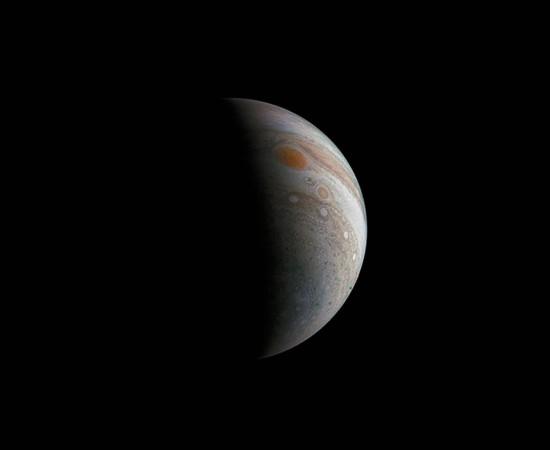
A citizen scientist, Roman Tkachenko, used a raw image taken by NASA's Juno spacecraft and recreated a beautiful picture of a half-lit Jupiter.
Also Read: Mysterious dark streaks on Venus may hint at the possibility of life
The image shows Jupiter with its prominent Great Red Spot -- an enormous, hurricane-like storm present in the atmosphere of the gas-giant.
Another reddish storm, dubbed Oval BA, can be seen right below the Great Red Spot in the picture.
The image also shows a stunning series of storms in the shape of white ovals, referred to as 'the string of pearls'.
The image was captured by the Juno spacecraft during its third flyby of Jupiter on December 11, 2016 from a distance of around 458,800 kilometers (285,100 miles), a NASA statement said.
Flybys at such proximity are carried out by the Juno spacecraft in a span of 54 days. The present orbital path of Juno around the gas-giant planet is extremely elliptical, Space.com reported.
NASA's Jet Propulsion Laboratory (JPL), operates the space probe. The probe was launched on August 5 2011 from the Cape Canaveral Air Force Station.
Juno entered the polar orbit of Jupiter on July 4, 2016 as part of the New Frontiers program with a view to explore the planet for 20 months. It became the second craft to orbit Jupiter after the Galileo orbiter. It orbited the planet from 1995 to 2003.
Juno's mission is to assess the magnetic and gravity fields, as well as the magnetosphere of the planet. Jupiter's magnetosphere refers to a cavity formed by the magnetic field of the planet in the solar wind. It is found to be the most powerful and largest planetary magnetosphere in our solar system. This magnetosphere spreads over a region of seven million kilometers in the direction of the Sun and almost reaches Saturn's orbit.
Juno is one of the fastest craft devised by man, travelling at a speed of 250,000 km/h. At the time of orbital insertion, Nasa fired Juno's main rocket in reverse to stabilise spacecraft and settle into an orbit, a report stated.
Jupiter's atmosphere consists of around 75% Hydrogen, with much of the rest being Helium. Jupiter's core is thought to comprise two layers, one of metallic Hydrogen (which may be in a fluid state and present itself as a sea around the core) and an inner layer comprising molecular Hydrogen.
The temperature at Jupiter's core is estimated to be around 9,700 C with a pressure in excess of 200 Giga pascals (to put that in perspective, the pressure on Earth at sea level is 101.325 kilo pascals). That's over 200 million times the pressure you'd feel on the surface of the Earth!














